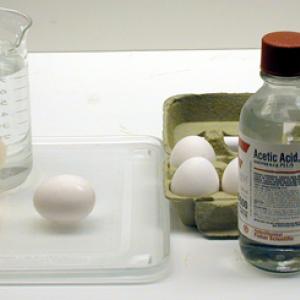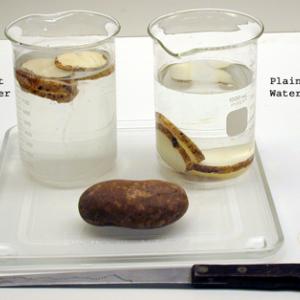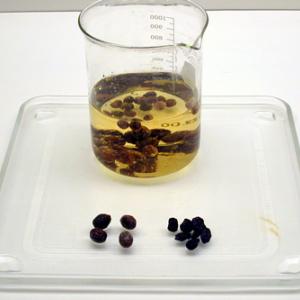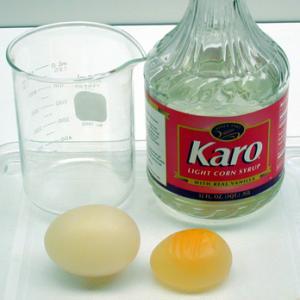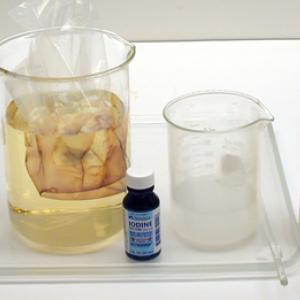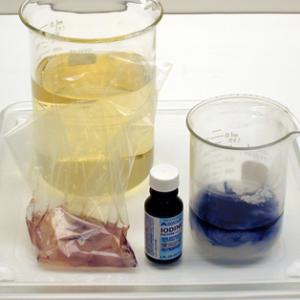College of Liberal Arts & Sciences
4D50.70 - Permeable Membrane - Osmosis
NOTE: All of these demonstrations will require at least 24 to 48 hours advanced notice.
Dissolve the shell off of several eggs with the vinegar. This will take at least 12 hours. Compare the naked egg to a regular egg with a shell and notice the dramatic increase in size. This increase is due to absorption of water through the permeable membrane.
Prepare two beakers, one with salt water and one with plain water. Cut some 1/4" slices from a potato and drop into each beaker. Wait 20 to 30 minutes. Pull the slice out of the plain water and observe that it does not bend easily and will in fact break crisply. Do the same to the slice in the salt water and observe that is bends quite readily and is very hard to break. This is due to the movement of water from the potato cells to the salt water.
Place the raisins in a beaker of plain water and let stand overnight. Compare regular raisins to the soap raisins.
Take one of the naked eggs and place into a beaker of corn syrup and let stand overnight. The egg will lose water to the corn syrup and will come out looking much like a large raisin.
Make a saturated solution of corn starch and place about 4 oz of this into the Hy-Vee sandwich bag. (These bags work well because they will hold water without leaking but will allow gas or small atoms to pass through). Put about 300 ml of water in a beaker and place about 20 to 30 drops of iodine into this. The water will remain clear or will have a slight yellow tint. Place the sandwich bag into the iodine water and after 1/2 hour observe that the starch inside the bag is turning dark blue or black. As a check you can add several drops of iodine to the starch solution and observe a very dark blue color.
- James N. Boyd, "Osmosis: A Model for First-Year Physics", TPT, Vol. 27, # 3, Mar. 1989, p. 196.
- Theodore Reiff, J. A. G. McClelland, Lewis Epstein, and James Boyd, "Osmosis Revisited", TPT, Vol. 27, # 9, Dec. 1989, p. 644.
- Eric M. Kramer, David R. Myers, "Five Popular Misconceptions about Osmosis", AJP, Vol. 80, # 8, August 2012, p. 694.
- Uri Lachish, "Osmosis and Thermodynamics", AJP, Vol. 75, # 11, p. 997, Nov. 2007.
- Russell K. Hobbie, "Osmotic Pressure in the Physics Course for Students of the Life Sciences", AJP, Vol. 42, #3, March 1974, p. 188.
- Gregory P. Thiel, "Salty Solutions", Physics Today, June 2015, p. 66.
- Gregory P. Thiel, "'Salty' Conversation", Physics Today, Vol. 86, # 12. December 2015, p. 13.
- Neal E. Reid, "'Salty' Conversation", Physics Today, Vol. 86, # 12. December 2015, p. 13.
- Jonathan Allen, "'Salty' Conversation", Physics Today, Vol. 86, # 12. December 2015, p. 12.
- George M. Hopkins, "Pressure by Endosmose", Experimental Science, p. 70.
- Charles Vivian, "How to "Kill" a Potato", Science Experiments & Amusements For Children, p. 46.
- Janice VanCleave, "Determine Which Type of Polymer Food Wrap Is Best at Preventing Food Dehydration", Super Science Challenges, p. 68.
- Janice VanCleave, "Determine How the Concentration of a Salt Solution Affects the Rate of Osmosis", Super Science Challenges, p. 37.
- Anthony Arico, "Osmosis and Turgor Pressure Models", The Science Teacher, September 1989, p. 78.
- Anthony Arico, "Diffusion Model", The Science Teacher, September 1989, p. 72.
- Daniel V. Schroeder, "Osmotic Pressure", An Introduction to Thermal Physics, Ch. 5, p. 202.
- Kerson Huang, "Osmotic Pressure", Statistical Mechanics, 2nd Ed., p. 43.
- Janice VanCleave, "Naked Egg", Biology for Every Kid - 101 Easy Experiments That Really Work, p. 146-147.
- Janice VanCleave, "Limp Spuds", Biology for Every Kid - 101 Easy Experiments That Really Work, p. 10-11.
- Janice VanCleave, "Fluffy Raisins", Biology for Every Kid - 101 Easy Experiments That Really Work, p. 12-13.
- Janice VanCleave, "Shrinking Egg", Biology for Every Kid - 101 Easy Experiments That Really Work, p. 148-149.
- Janice VanCleave, "In But Not Out", Biology for Every Kid - 101 Easy Experiments That Really Work, p. 144-145.
- H.J. Press, "Ghostly Noise", Giant Book of Science Experiments, p. 270.
- Joseph Frick, "#95 - Endosmosis", Physical Technics: Or, Practical Instructions for Making Experiments in Physics and the Construction of Physical Apparatus with the Most Limited Means", p. 107.
Disclaimer: These demonstrations are provided only for illustrative use by persons affiliated with The University of Iowa and only under the direction of a trained instructor or physicist. The University of Iowa is not responsible for demonstrations performed by those using their own equipment or who choose to use this reference material for their own purpose. The demonstrations included here are within the public domain and can be found in materials contained in libraries, bookstores, and through electronic sources. Performing all or any portion of any of these demonstrations, with or without revisions not depicted here entails inherent risks. These risks include, without limitation, bodily injury (and possibly death), including risks to health that may be temporary or permanent and that may exacerbate a pre-existing medical condition; and property loss or damage. Anyone performing any part of these demonstrations, even with revisions, knowingly and voluntarily assumes all risks associated with them.
